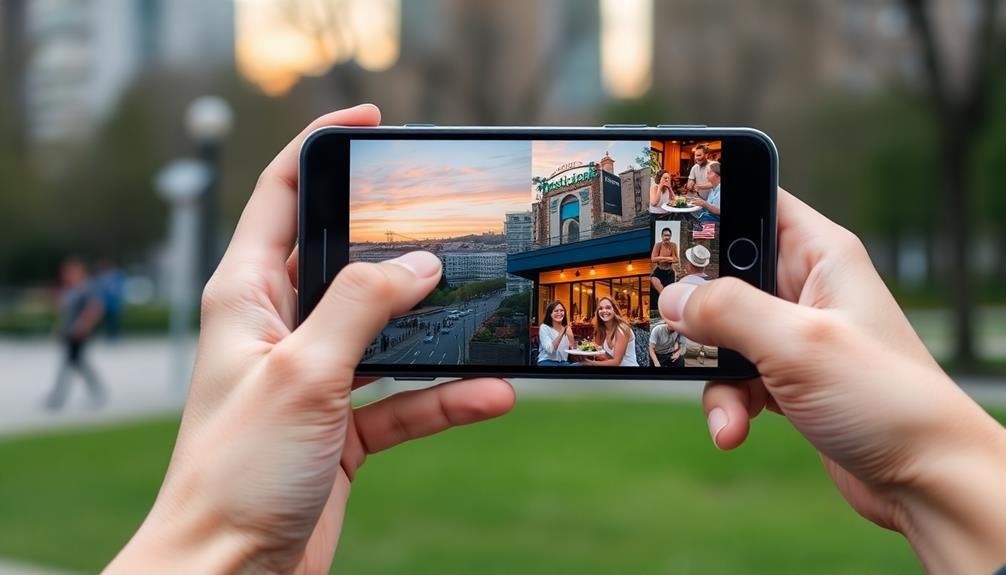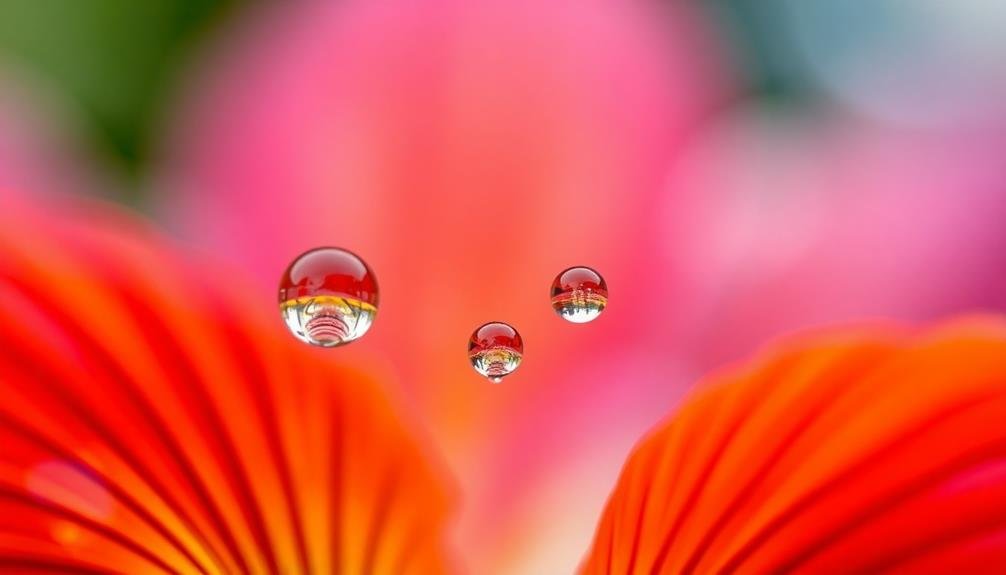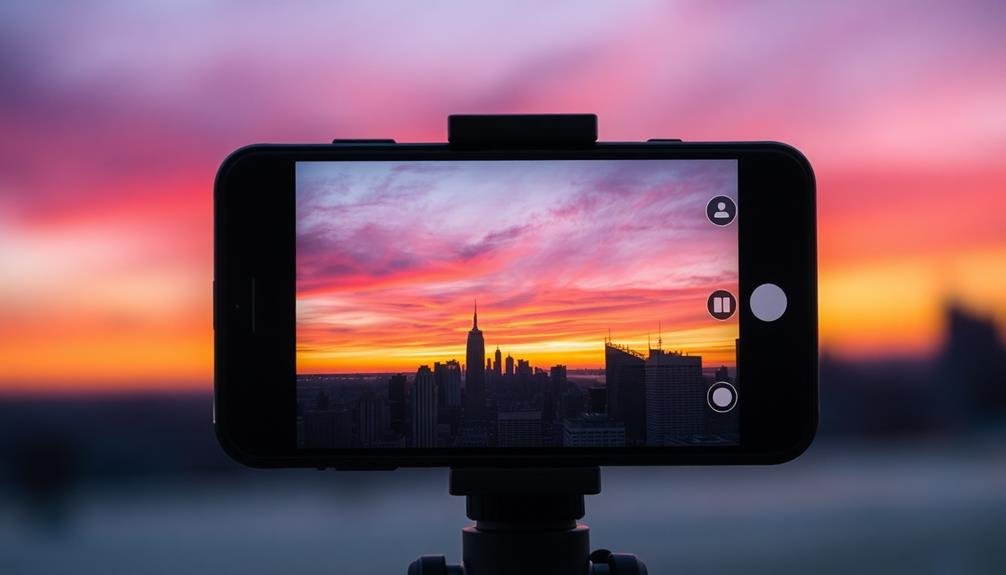To create compelling phone photo story sequences, start by establishing a clear visual theme that reflects your narrative's mood. Use consistent framing techniques, like the rule of thirds, to maintain cohesion throughout your images. Experiment with sequential compositions, capturing a series of photos that flow seamlessly and show progression. Play with light and shadows to add depth and drama to your shots, utilizing natural light and adjusting exposure settings. Finally, incorporate emotional progression by planning images that gradually build tension or excitement. By mastering these techniques, you'll be well on your way to crafting engaging visual stories that leave a lasting impression on your audience.
Establish a Clear Visual Theme

When establishing a clear visual theme, consider the overall mood and story you want to convey through your phone photos. Think about the emotions you're trying to evoke and the narrative you'd like to create. Choose a consistent color palette, lighting style, or subject matter that aligns with your theme.
Start by brainstorming ideas and creating a mood board to visualize your concept. This can help you stay focused on your theme throughout the photo sequence. As you shoot, pay attention to elements like composition, lighting, and framing that contribute to your chosen theme.
Don't be afraid to experiment with different filters or editing techniques to enhance your visual theme. However, ascertain that you apply these consistently across all photos in your sequence. Remember that a strong theme doesn't mean every photo needs to be identical; rather, it's about creating a cohesive narrative through visual cues.
Consider the order of your photos and how they flow together. Each image should build upon the previous one, reinforcing your theme and guiding viewers through your story.
Use Consistent Framing Techniques

Consistency is key when it comes to framing your phone photos. To create a cohesive story sequence, you'll want to maintain similar framing techniques throughout your shots. This doesn't mean every photo should be identical, but rather that there should be a unifying element in how you compose your images.
Consider using the rule of thirds, where you divide your frame into a 3×3 grid and place key elements along these lines or at their intersections. Alternatively, you might opt for symmetrical framing or consistent use of leading lines. Whatever technique you choose, stick with it for the majority of your sequence to create a visual rhythm.
Here's a quick guide to framing techniques:
| Technique | Description | Best Used For |
|---|---|---|
| Rule of Thirds | Subject on grid lines | Balanced composition |
| Symmetry | Mirror-like balance | Formal, striking images |
| Leading Lines | Lines guide eye to subject | Directing viewer's focus |
Don't be afraid to occasionally break your chosen framing rule for emphasis. A sudden change in framing can draw attention to a particularly important shot in your sequence, creating a powerful visual punctuation mark in your photo story.
Experiment With Sequential Compositions

In addition to consistent framing, experimenting with sequential compositions can elevate your phone photography. This technique involves creating a series of images that tell a story or convey a message when viewed together. You'll want to capture multiple shots that flow seamlessly from one to the next, creating a visual narrative.
To create compelling sequential compositions, consider these elements:
- Progression: Show a clear development or change over time
- Repetition: Use recurring elements to tie the images together
- Contrast: Highlight differences between images for impact
- Rhythm: Establish a visual tempo through spacing and pacing
Start by planning your sequence. Visualize how each image will contribute to the overall story. As you shoot, maintain consistency in lighting and color tones to guarantee a cohesive look.
Experiment with different angles and perspectives to add variety while keeping the subject matter connected. Don't be afraid to mix up your compositions.
Try combining wide shots with close-ups or alternating between portrait and landscape orientations. Remember, the goal is to create a series that's more powerful when viewed as a whole than any single image on its own.
Play With Light and Shadows

Light and shadows are powerful tools in photography that can transform an ordinary scene into something extraordinary. When crafting your photo story sequence, pay attention to how light interacts with your subjects and surroundings. Use natural light to your advantage by shooting during golden hour or experimenting with backlighting. Don't shy away from shadows; they can add depth and drama to your images.
Try these techniques to enhance your light and shadow play:
| Technique | Effect | Best Time |
|---|---|---|
| Silhouettes | Dramatic contrast | Sunset/Sunrise |
| Dappled light | Texture and interest | Midday through trees |
| Long shadows | Depth and perspective | Early morning/late afternoon |
| Rim lighting | Subject separation | Golden hour |
| Low-key lighting | Moody atmosphere | Night or controlled indoor |
Remember to adjust your phone's exposure settings to capture the right balance of light and shadow. Use the HDR mode for high-contrast scenes, or manually lower the exposure to preserve highlights. As you sequence your photos, consider how the interplay of light and shadow can create a narrative flow, guiding the viewer's eye from one image to the next.
Incorporate Emotional Progression

Emotional progression breathes life into your photo story sequence, transforming it from a mere collection of images into a compelling narrative. As you plan your shots, consider how you'll guide your viewers through a range of emotions.
Start with an image that sets the tone, then gradually build tension or excitement through subsequent photos. Use visual cues, colors, and composition to evoke specific feelings in each frame.
To incorporate emotional progression effectively:
- Identify the core emotion you want to convey
- Plan a series of images that gradually intensify or shift that emotion
- Use lighting, angles, and subject matter to reinforce the emotional journey
- End with a powerful image that leaves a lasting impression
Frequently Asked Questions
How Many Photos Should Be Included in a Phone Photo Story Sequence?
You'll want to include 5-10 photos in your story sequence. This range allows you to capture key moments without overwhelming viewers. Remember, it's quality over quantity, so choose your shots carefully to tell a compelling narrative.
What Apps Are Best for Editing and Arranging Photo Story Sequences?
You'll find several great apps for editing and arranging photo story sequences. Try Canva, Adobe Spark, or StoryChic for user-friendly interfaces. VSCO and Snapseed offer powerful editing tools. Instagram's built-in features are also worth exploring for quick sequences.
Can I Mix Portrait and Landscape Orientations in a Single Sequence?
You can mix portrait and landscape orientations in a single sequence. It'll add visual interest and variety to your story. Just guarantee you're consistent with the overall layout and flow to maintain a cohesive narrative throughout your sequence.
How Do I Share My Photo Story Sequence on Social Media Effectively?
You'll want to choose the right platform, use hashtags strategically, and create engaging captions. Post your sequence as a carousel or album, ensuring the first image is enchanting. Consider timing and audience preferences for maximum impact.
Are There Specific File Formats Recommended for Phone Photo Story Sequences?
When sharing photo story sequences, you'll want to use JPEGs for individual images and MP4 for video sequences. They're widely supported across platforms. If you're combining photos into a single file, consider using PDF format.
In Summary
You've now got the tools to create compelling photo story sequences with your phone. Remember to tie your images together visually, maintain consistent framing, and experiment with composition. Don't forget to play with light and shadows for added depth. Most importantly, infuse your sequence with emotion to engage your viewers. With practice, you'll master these techniques and tell powerful visual stories right from your pocket. Keep shooting and exploring!





Leave a Reply